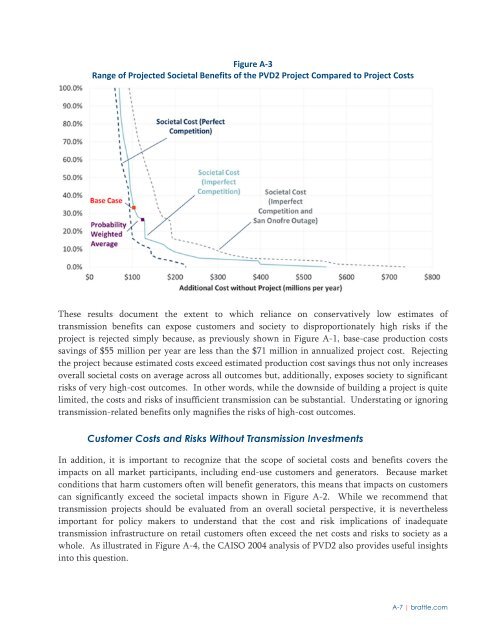THE BRATTLE GROUP
pvrbYG
pvrbYG
You also want an ePaper? Increase the reach of your titles
YUMPU automatically turns print PDFs into web optimized ePapers that Google loves.
Figure A‐3<br />
Range of Projected Societal Benefits of the PVD2 Project Compared to Project Costs<br />
These results document the extent to which reliance on conservatively low estimates of<br />
transmission benefits can expose customers and society to disproportionately high risks if the<br />
project is rejected simply because, as previously shown in Figure A-1, base-case production costs<br />
savings of $55 million per year are less than the $71 million in annualized project cost. Rejecting<br />
the project because estimated costs exceed estimated production cost savings thus not only increases<br />
overall societal costs on average across all outcomes but, additionally, exposes society to significant<br />
risks of very high-cost outcomes. In other words, while the downside of building a project is quite<br />
limited, the costs and risks of insufficient transmission can be substantial. Understating or ignoring<br />
transmission-related benefits only magnifies the risks of high-cost outcomes.<br />
Customer Costs and Risks Without Transmission Investments<br />
In addition, it is important to recognize that the scope of societal costs and benefits covers the<br />
impacts on all market participants, including end-use customers and generators. Because market<br />
conditions that harm customers often will benefit generators, this means that impacts on customers<br />
can significantly exceed the societal impacts shown in Figure A-2. While we recommend that<br />
transmission projects should be evaluated from an overall societal perspective, it is nevertheless<br />
important for policy makers to understand that the cost and risk implications of inadequate<br />
transmission infrastructure on retail customers often exceed the net costs and risks to society as a<br />
whole. As illustrated in Figure A-4, the CAISO 2004 analysis of PVD2 also provides useful insights<br />
into this question.<br />
A-7 | brattle.com


